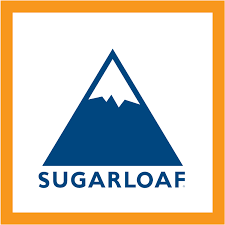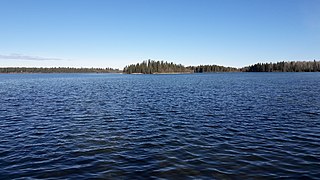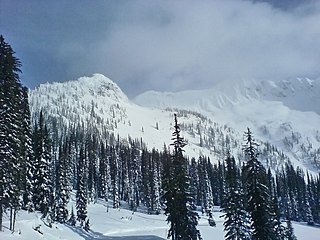
The White Mountains Region is a tourism region designated by the New Hampshire Division of Travel and Tourism. It is located in northern New Hampshire in the United States and is named for the White Mountains, which cover most of the region. The southern boundary of the region begins at Piermont on the west, and runs east to Campton, then on to Conway and the Maine border. The northern boundary begins at Littleton and runs east to Gorham and the Maine border. The region to the north is known as the Great North Woods Region, which should not be confused with the larger and more general Great North Woods.

Ski touring is skiing in the backcountry on unmarked or unpatrolled areas. Touring is typically done off-piste and outside of ski resorts, and may extend over a period of more than one day. It is similar to backcountry skiing but excludes the use of a ski lift or transport.

Sugarloaf is a ski area and resort located on Sugarloaf Mountain in Carrabassett Valley, western Maine. It is the second largest ski resort east of the Mississippi in terms of skiable area and snowmaking percentage (95%); its continuous vertical drop of 2,820 feet (860 m) is the second longest in New England. Sugarloaf recorded a total of 352,000 skier visits in the 2005–2006 season, ranking it second among Maine resorts and 11th in New England.

Green Mountain National Forest is a national forest located in Vermont, a temperate broadleaf and mixed forest typical of the New England/Acadian forests ecoregion. The forest supports a variety of wildlife, including beaver, moose, coyote, black bear, white-tailed deer, wild turkey, and ruffed grouse. The forest, being situated in Vermont's Green Mountains, has been referred to as the granite backbone of the state.

Crimson Lake Provincial Park is a provincial park located in Alberta, Canada, 14 kilometres (8.7 mi) west of Rocky Mountain House, off the David Thompson Highway along secondary highway 756.

Killington Mountain Resort & Ski Area is a ski resort in Rutland County, Vermont, United States, near the town of Killington. It is the largest ski area in the eastern U.S., and has the largest vertical drop in New England at 3,050 feet. The mountain has been nicknamed the "Beast of the East."

Diamond Peak is a ski resort in the western United States, located in Incline Village, Nevada. Near the northeast shore of Lake Tahoe, the resort has 6 chairlifts, 27 runs, and 14 open glades/tree skiing on its 655 acres (2.65 km2) of terrain.

Nakiska is a ski resort in western Canada, in the Kananaskis Country region of the province of Alberta. It is located 83 km (52 mi) from Calgary, west on Highway 1 and south on Highway 40. "Nakiska" is a Cree word meaning "to meet" or "meeting place."

Whitewater Ski Resort is a ski resort in western Canada, located a 25-minute drive from Nelson in southern British Columbia. In the Selkirk Mountains, the resort is situated in Ymir bowl, beneath the 2,400-metre-high (7,874 ft) Ymir Mountain. The Selkirks receive plentiful, dry snow, and the location in a high alpine bowl provides an annual snowfall average of approximately 12 m.

A tree well, also known as a spruce trap, is the space around a tree under its branches that does not get the same amount of snow as the surrounding open space. This creates a void or area of loose snow below the branches and around the trunk that is dangerous to any hikers, snowshoers, skiers, snowboarders, and snowmobilers who fall into them. If someone lands in such a well, often as a result of a fall, it can be too deep for them to climb up the surrounding loose snow before they are buried. Making the situation more dangerous, they often fall into the well head-first and as the result of an accident which could leave them injured or unconscious.

The Stevens Pass Ski Area is a ski area in the Cascade Range of Washington in the United States. It is located at the crest of Stevens Pass at a base elevation of 4,061 feet (1,238 m) above sea level and peak elevation at 5,845 feet (1,782 m). The Mill Valley "backside" of the resort drops to a minimum elevation of 3,821 feet (1,165 m). Total skiable terrain includes 37 major runs covering 1,125 acres (4.55 km2). The ski area is accessed via U.S. Route 2, which connects to nearby Leavenworth.

Gore Mountain is an alpine ski resort on Gore Mountain in the Adirondack Mountains, located in North Creek, New York. The mountain is a popular winter destination, attracting skiers from all over the east. It is the largest ski area in New York and is located about one hour from the Capital District (Albany) metro area.

Ski Cooper is an alpine ski resort in Colorado, one of the oldest in the state. Opened as Cooper Hill Ski Area in 1942, the ski area served as the training site for the 10th Mountain Division, based at nearby Camp Hale during World War II.

Crabbe Mountain is a Canadian alpine ski hill in Central Hainesville, New Brunswick, near the intersection of Route 104 and Route 610. Crabbe Mountain was first skied in the spring of 1959 when three explored and cut the first trail on the mountain, Tippy Canoe.

Backcountry snowboarding is snowboarding in a sparsely inhabited rural region over ungroomed and unmarked slopes or pistes in the backcountry, frequently amongst trees, usually in pursuit of fresh fallen snow, known as powder. Often, the land and the snow pack are not monitored, patrolled, or maintained. Fixed mechanical means of ascent such as ski lifts are typically not present, but alternative means such as splitboarding, hiking, snowshoeing and helicopters ("heliskiing") are sometimes used to reach the mountain's peak.

The Snow Mountain Wilderness is a 60,076-acre (243.12 km2) federally designated wilderness area located 65 miles (105 km) north of Santa Rosa, California, USA in the Mendocino National Forest. The U.S. Congress passed the California Wilderness Act of 1984 which created 23 new wilderness areas including Snow Mountain. It lies within the North Coast Range of mountains.

Cedars of Lebanon State Park is a state park in Wilson County, Tennessee, in the southeastern United States. It consists of 900 acres (364 ha) situated amidst the 9,420-acre (3,810 ha) Cedars of Lebanon State Forest. The park and forest are approximately 10 miles (16 km) south of Lebanon, Tennessee.

Burke Mountain Ski resort is a mid-size ski resort open to skiing and snowboarding in northeast Vermont. It is located on Burke Mountain and is home to Burke Mountain Academy, a ski academy.

Mount Seymour Provincial Park is a park in Vancouver, British Columbia's North Shore Mountains. With an area of 35 square kilometres, it is located approximately 15 kilometres north of Downtown Vancouver. The park, named after Frederick Seymour, was established in 1936. Mount Seymour Provincial Park provides visitors with a variety of recreational activities and animals with natural habitat.
This glossary of skiing and snowboarding terms is a list of definitions of terms and jargon used in skiing, snowboarding, and related winter sports.



















